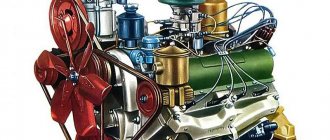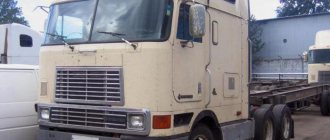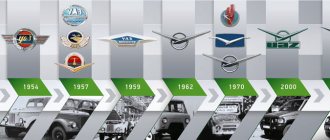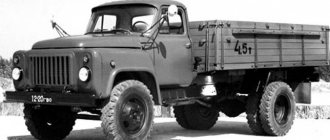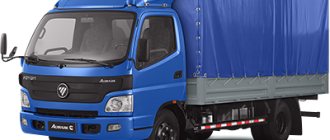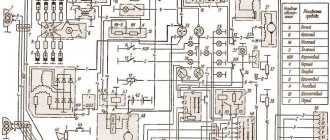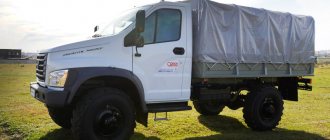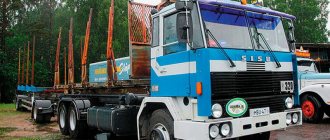First steps
By the early fifties, the ZIS-150, the development of which began in the pre-war period, became obsolete. ZIL-164, serial production of which began in 1957, turned out to be only a temporary solution. In fact, it was a deep modernization of the same 150th model. The state needed a completely new car. The first prototypes of the ZIL-130 with a lifting capacity of four tons were built at the end of 1956. Under the hood, an in-line six-cylinder ZIL-120 engine, familiar from the previous model, was installed. But soon this engine was abandoned in favor of a new unit. The V8 engine with a displacement of six liters produced 150 hp. The compression ratio was only 6.5 units, but the engine could run on 72-octane gasoline. It took six years to fine-tune and test the car, and the first experimental batches were assembled in 1962. But the machines required additional development tests. Large-scale production started only on October 1, 1964.
Engine ZIL-508
The overhead valve V8 engine was similar in design to the engine of the ZIL-111 limousine.
However, on the 130th, the six-liter engine developed only 150 hp. But I ate 72 gasoline. The overhead valve V8 engine was similar in design to the engine of the ZIL-111 limousine. However, on the 130th, the six-liter engine developed only 150 hp. But I ate 72 gasoline.
Appearance to the people
The truck turned out to be innovative at that time, with a level of comfort unprecedented for a Soviet driver. The steering was power-assisted, and the five-speed gearbox was equipped with synchronizers for all but first gears. The car moved off easily from the second, and the first stage was needed only for off-road conditions or very steep climbs. That's why they made it straight-toothed.
Transmission
ZIL-130 has a drive to the far axle. The clutch is designed on a dry principle and has 1 disc. The gearbox has 5 stages, operates on a mechanical principle, and is also characterized by 2 synchronizers. The gears of the gears are characterized by constant meshing. The exception is modules 1 and 5.
When this car first came off the assembly line, the design features of the gearbox seemed innovative to many. Subsequently, this device underwent many improvements, with the driven shaft undergoing special changes.
The outer neck of this device is marked with a special bearing. Many nodes have also undergone significant changes that are necessary to improve the model.
Features of work
The driveshaft in the design serves for optimal transmission of torque located on the reverse side of the axle, which is carried out as part of the gearbox system. The model developed according to the original plan and intended for agriculture, as well as its extended version, uses 2 shafts working with an intermediate type support. It is tightly attached to the frame.
There is a shortened version of this design, where there is 1 shaft, which requires an intermediate type support to support it.
Prototype ZIL-130, 1956
The photo shows a prototype of the first series, built in 1956.
The photo shows a prototype of the first series, built in 1956.
The exterior of the truck was very bold, even by international standards. The appearance was entrusted to a young graduate of Stroganovka (Moscow School of Art and Industry) Erik Vladimirovich Sabo. Until then, and even later, there was nothing like this among our cargo vehicles. Embossed radiator grille, stylish cabin contours and, most importantly, a panoramic windshield! Only the government GAZ-13 Chaika and ZIL-111 could boast of such elegance.
ZIL-130 from the first experimental batch in 1962
The car is from the first experimental batch of 1962.
To fine-tune the new ZILs, they were sent on long test runs in the Far North. The car is from the first experimental batch of 1962. To fine-tune the new ZILs, they were sent on long test runs across the Far North.
Another distinctive feature of the new car was the color. Before this, the main color for the vast majority of Soviet trucks was khaki - in order to quickly mobilize in case of war. But the 130 received a sky blue cab with a white front end. Of course, there were other colors, including dark green. But most of the cars were blue.
ZIL-130
Serial ZIL-130 model 1964.
The car was produced in this form until 1978. Serial ZIL-130 model 1964. The car was produced in this form until 1978.
ZIL-130 quickly won the love of drivers. It turned out to be beautiful, dynamic and comfortable. The carrying capacity was five tons - more than the vehicle's own weight. But the main thing is that it turned out to be very durable. The estimated mileage before major repairs of 300 thousand kilometers was a very decent figure for the sixties. In May 1973, large-scale endurance tests of the 130th were carried out at the NAMI test site. He covered a distance of 25 thousand kilometers in 12 days. At the same time, not a single breakdown was recorded. But the incredibly successful design partly became the curse of the plant...
Ergonomics
Almost the complete set of modifications of the ZIL-130 is equipped with an engine consisting of 8 cylinders (for example, Lawn Next has 4 cylinders). They are arranged in a standard sequence, forming the letter V. The motor operates on the principle of liquid cooling. Some types of trucks that were produced for export abroad were equipped with engines produced in other countries.
Sometimes a pre-start heater was installed in the design of the machines. This is necessary in cases where the machine is designed for use at low temperatures, that is, in harsh climatic conditions.
Dump truck ZIL-130
ZIL-130 at autocross
Good power supply and a durable cabin made the ZIL-130 an excellent crossman.
The 130s continue to compete in autocross today. Good power supply and a durable cabin made the ZIL-130 an excellent crossman. The 130s continue to compete in autocross today.
Late shift
Of course, no one was going to rest on their laurels. No matter how successful the design, progress does not stand still. And we need to prepare a successor. But in the late 60s, ZIL designers were busy developing a family of cabover trucks with a diesel engine and a load capacity of eight tons. In December 1969, the first samples of the new ZIL-170 vehicle were assembled, which later became the KAMAZ-5320. Only in 1976, when mass production of KAMAZ vehicles was launched in Naberezhnye Chelny, the Likhachev plant finally began developing its own car, the successor to the 130. However, time was lost. ZIL-130 was completely outdated by that time.
Application
ZIL-130 trucks and chassis were widely used in the national economy. Based on the machine, buses (Tajikistan brand), dump trucks, tanks, delivery and technical vans were produced. A large number of ZIL-130 chassis were used to create fire fighting vehicles - tank trucks, hose trucks, pumping stations.
The ZIL-130E modification, which had a number of electrical equipment components from the 131st model, was intended for deliveries to the Soviet Army. The equipment included additional canisters with a capacity of 10 and 20 liters, a set of entrenching tools, and blackout caps for the headlights.
On request, sides of increased height were installed with the possibility of installing arches for the awning. A second fuel tank capable of holding 170 liters of gasoline could be installed on the right side member.
Dump truck MMZ-555, also known as ZIL-130D.
One of the first modifications was the MMZ-555 dump truck, also known as ZIL-130D.
One of the first modifications was the MMZ-555 dump truck, also known as ZIL-130D.
Only in 1978, the updated 130-76 car was put into production, which is easily distinguished by its modified “face” (the sidelights and headlights swapped places). And in 1986, the car received a new index - 431410. But no matter what it was called, it was still the same 130, the main drawback of which was the voracious gasoline engine. And if the diesel unit for KAMAZ was created by the Yaroslavl Motor Plant, then ZIL had to develop its own diesel engine from scratch. Work on the car and engine was long and painful. As a result, the successor to the 130th, ZIL-4331, reached the production line only in 1987. But not all cars were equipped with the new ZIL-645 diesel engine. Most new cars were produced with the same gasoline engine.
How the motor works
The ZIL unit number 130 received eight cylinders arranged in a V8 format. This means that they are placed at an angle of 90 degrees relative to each other. This arrangement makes the power unit more compact and lightweight, requiring less space for installation under the hood. This arrangement allows you to place attachments on it.
During the operating cycle, the motor makes four strokes. The air-fuel mixture is fed through a two-chamber K-88 carburetor device. The engine capacity produced at the ZIL automobile plant of the 130 series is 5.969 cm3. The operation of the motor is limited by the maximum speed limiter.
Between the rows of cylinders are located:
- fuel supply pump;
- carburetor device;
- air purification filter;
- switchgear breaker;
- oil filter;
- inlet pipeline.
In the front part there is a water supply pump, a compressor device for pumping air, a fan, and also pulleys for the drive.
The crank mechanism is considered the basis of this power plant. The crankshaft and camshaft are connected by gears. The camshaft cams, with the help of auxiliary elements: pushers, rods, force the rocker arms to move, which in turn act on the valves. They return to their previous position due to installed springs.
The K-88 carburetor operates on the falling flow principle and has a balanced float chamber.
Materials
The frame of the structure is made of improved quality cast iron. It has increased resistance to the formation of corrosion foci.
The material for the manufacture of two cylinder heads was an alloy of aluminum with other metals, which enhance the strength characteristics of the housing. Displacers are made of a similar material and are equipped with several rings. The top two, compression ones, are made of cast iron and coated with chrome. The purpose of the compound third is to remove oil. It is made from an alloy of steel and chromium. Hollow, floating fingers are also made of steel.
Let's list the materials for manufacturing the remaining components of the motor:
- connecting rods are made of steel, they have an I-section and lubricate the piston pin;
- liners are made of steel tape and aluminum alloy;
- camshaft - five-bearing, made of steel;
- The crankshaft is forged, steel, and also has five bearings. It is equipped with lubrication channels;
- the flywheel is made of cast iron, the crown that starts the motor from the starter is made of steel.
- The power unit block is equipped with sleeves with sealing rings at the bottom. Let's look at the design of valves. The intakes are driven by the camshaft. They are located in the cylinder head of the engine compartment.
- The exhaust valves of internal combustion engines are hollow and have a heat-resistant overlay. They are equipped with a mechanism for forced rotation.
- The material for the pushers was steel, reinforced on top with cast iron surfacing. The rocker arms are also steel, they are equipped with bronze bushings.
- The intake manifold is made of aluminum alloy and is common to the cylinder banks. The fuel mixture coming from the carburetor is heated through a cavity located between the two heads of the block.
- Two gas outlet pipes are installed on each side of the block, made of cast iron.
Long-wheelbase modification ZIL-431510
In 1986, ZIL-130 changed its index to 431410 (in the photo there is a long-wheelbase modification 431510).
The car was produced in this form until 1994. In 1986, ZIL-130 changed its index to 431410 (in the photo there is a long-wheelbase modification 431510). The car was produced in this form until 1994.
In fact, the new truck was a deeply modernized “one hundred and thirty” with a new cab. Moreover, both generations of cars were produced in parallel. The last ZIL-431410 rolled off the assembly line already in post-Soviet times - in 1994. Over the thirty years of production, the ZIL-130 has acquired a large number of modifications. And the total circulation was almost three and a half million copies! This makes the 130 not only legendary, but also one of the most popular cars in the history of our automobile industry.
Advantages and disadvantages
Pros of the car
- Record low cost of a car;
- Low requirements for the required fuel;
- Small dimensions allow for good maneuvering even on city roads;
- Good maintainability;
- It's not hard to find the parts you need;
- Good maneuverability and high ground clearance;
- Hydraulic power steering.
Cons of the car
- Minimum vehicle speed;
- Not a record carrying capacity of the machine;
- Year of issue;
- Many parts often fail;
- High fuel consumption;
- Lack of comfortable conditions in the cabin (by modern standards);
- Problems with starting in the cold season;
- Low noise insulation and thermal insulation of the interior;
- Uncomfortable chairs.
ZIL-4331
ZIL-4331, the successor to the 130th, was clearly late for publication.
And it didn’t turn out quite the way it was intended. ZIL-4331, the successor to the 130th, was clearly late for publication. And it didn’t turn out quite the way it was intended.
His successor didn't come close to achieving the same popularity. With the transition to a market economy, a medium-duty truck with a gasoline engine found itself out of work. The ZIL-645 diesel engine was crude and required modifications, for which there was no longer enough money. The plant tried to launch the production of model 4331 with MMZ and Caterpillar engines. But everything is in vain. Demand was revived by the ZIL-5301 Bychok, developed in a short time, but the effect turned out to be temporary. We know very well how it all ended for ZIL. However, this is a completely different story. And today the 130th continues to serve faithfully in many enterprises and farms. This pensioner has long deserved peace. But I am sure that we will see the legendary truck on the roads for a long time.
Personal acquaintance |
| I myself had the opportunity to communicate with the 130th ZIL, while still a student at a driving school. For category C training, there were two ZIL trucks in the fleet: 4331 and 431410 (read: 130th). I got the second one. Almost twelve years have passed since then, but the memories of managing ZIL are still fresh. The engine started easily and ran very smoothly. They say that with a properly tuned motor, the compressor should be heard better than the motor itself. It was just about a training machine - the engine rustled barely noticeably. Interestingly, ZIL-4331, which was fifteen years younger, was in much worse condition. From second gear the 130 started off very easily and accelerated very confidently. Feedback and quick reactions on the steering wheel, which we evaluate during comparative tests, are not about this car. For ZIL, the main thing is that the steering wheel turns easily. The only thing that caused discomfort in the crowded traffic on the streets of Moscow was poor visibility. Still, the hood and front fenders were high. But I still remember that car with warmth. |
Options and prices
Most car enthusiasts buy these trucks and turn them into masterpieces. On the Internet you can find many photographs of ZIL after its upgrade. You can buy a real Russian truck for a very modest price - from 35 to 50,000 Russian rubles.
It is clear that their general and technical condition is not ideal, but it is quite easy to purchase the necessary spare parts for the car. Those cars that have been preserved in good condition are sold a little more expensive, the cost can reach up to 380,000 rubles.
Options
On the platform of the ZIL-130 truck, the automobile plant produced cars:
- ZIL-130G - was produced for the transportation of various large cargo and low-density elements, as well as for towing a trailer, the total weight category of which does not exceed 8 tons. The vehicle itself is capable of transporting up to 6 tons of cargo (wheelbase 4,500 mm);
- ZIL-130V1 is a truck-type tractor designed for towing various semi-trailers, the total weight of which (this also includes the weight of the semi-trailer) is no more than 14.4 tons on hard road surfaces (wheelbase 3,300 mm);
- ZIL-130D1 – platform for building the ZIL-MMZ-4502 and ZIL-MMZ-555 dump truck; coped well with transporting trailers;
- ZIL-130D2 – a platform with a pneumatic outlet and a towing device, which is intended for the construction of a dump truck-tractor ZIL-MMZ-45022;
- ZIL-130B2 is also a platform with a pneumatic outlet, only for a trailer and a towing device, which was intended for the construction of a ZIL-MMZ-554M dump truck tractor for agriculture.
Apart from those that were not mentioned, the production could produce complete sets of machines that were intended for operation in different climates. Any similar model of the 130th has its own letter or digital code. The operating time of the machine and its reliability, as well as economic indicators, largely depend on the grinding of parts during the first time of operation.
Initially, the plant planned to produce the following standard models:
- ZIL-130A was the release of an onboard tractor for full operation with a trailer, the total weight of which is 8 tons. It is equipped with a combination brake valve, towing device and pneumatic and electrical connections for connecting the brake system and electrical devices of the trailer;
- ZIL-130G – long-wheelbase platform truck with 2 sectional side walls (wheelbase 4,500 mm);
- ZIL-130V – truck-type tractor with a short wheelbase (3,300 mm);
- ZIL-130VT is a truck-type tractor with a short wheelbase (33 cm) and a stronger rear axle;
- ZIL-130D – platform for a construction dump truck with a short wheelbase (33 cm);
- ZIL-130B is a platform for an agricultural dump truck with a wheelbase of 3,800 mm.
- ZIL-MMZ-555 – dump truck with rear loading. Built on the basis of ZIL-130D1. Due to the shortened wheelbase, the truck has good maneuverability.
When trucks were produced, a couple of significant modernizations of the ZIL-130 division were carried out in 1966 and 1977. Following the latter, the radiator grille was changed. At the request of the customer, it was possible to install a foreign-made motor in various modifications:
- Perkins345, 140 hp.
- Valmet 411BS, has 4 cylinders and operates with a power of 125 hp
- Leyland400, the presence of 6 cylinders and diesel fuel provide a power of 135 horses.
It is also possible to install a third non-driving axle to increase the load capacity. These frauds were carried out by subsidiaries outside the plant.
Device ZIL-130
Great Soviet Encyclopedia.
Volume one. In the section about the car, the header is an image with the 130th ZIL and its device. Great Soviet Encyclopedia. Volume one. In the section about the car, the header is an image with the 130th ZIL and its device.
ZIL-130 | |
| Overall dimensions: length/width/height/base | 6675/2500/2400/3800 mm |
| Curb/gross weight | 4300/10525 kg |
| Towed trailer weight | 8000 kg |
| Maximum speed | 90 km/h |
| Turning radius | 8.9 m |
| Fuel/fuel reserve | AI-72/170 l |
| Fuel consumption at a speed of 60 km/h | 29 l/100km |
| ENGINE | |
| Type | petrol |
| Location | front, longitudinal |
| Configuration/number of valves | V8/16 |
| Working volume | 5996 cm³ |
| Compression ratio | 6,5 |
| Power | 110/150 kW/hp at 3200 rpm |
| Torque | 401 Nm at 1800 - 2000 rpm |
| TRANSMISSION | |
| type of drive | rear |
| Transmission | M5 |
| Gear ratios: I/II/III/IV/V/Z.kh. | 7,44/4,10/2,29/1,47/1,00/7,09 |
| main gear | 6,32 |
| CHASSIS | |
| Suspension: front/rear | dependent spring |
| Steering | screw-nut, with hydraulic booster |
| Brakes: front/rear | drum, pneumatic |
| Tires | 260–508(P) |
Photo: from the author’s archive
ZIL-130: remembering the life of the legendary truck
Features of work
Displacers operate the mechanism by transforming the gas supply. The process involves: the crankshaft, the connecting rod itself and the pin installed in the displacer. In the lower half of the part there is a thickening with a hole. It is necessary to install the pin, which serves as a connecting element between the connecting rod head and the displacer. Steel hoops prevent damage to the cylindrical surface by limiting the stroke of the piston pin. The displacer pin connects the part to the shaft.
Cylinder block
It also contains sleeves. In the upper half of the latter, an insert is installed at a distance of 50 mm, made of anti-corrosion cast iron.
Here are the detail parameters:
- sleeve thickness – 7.5 mm;
- height – 188.5 mm;
- the diameter of the hole for the crankshaft supports can vary in the range from 79.5 to 79.525 mm.
The case is equipped with channels for water cooling. They are designed to protect the motor from overheating.
Crankshaft
This four-knee part of the power unit has five support points. Its main and connecting rod journals are hardened, which gives it greater strength and promotes long-term operation. For better balancing of the power unit, the crankshaft is made in the shape of a cross.
The crankshaft converts the thrust pressure. The front of the camshaft has a keyed retainer that holds the timing gear and friction wheel needed to activate the vane device. The rear part of the crankshaft is equipped with a flange for connecting it to the flywheel.
Here are the parameters of its components:
- crankshaft weight - 53.7 kg;
- the weight of the crankshaft of the ZIL-130 unit assembled with a flywheel is 77.92 kg, with a pulley and clutch mechanism – 102.6 kg;
- the diameter of the connecting rod journals varies from 65.48 to 65.50 mm;
- The D of the main journals varies from 74.48 to 74.50 mm.
The part is made of grade 45 steel.
Motor flywheel
This wheel stabilizes the operation of the power unit and makes its movement smooth. It also helps the displacers in overcoming the end positions of the stroke, making it easier to start from a standstill.
The flywheel is made of cast iron, its teeth, which launch the ZIL internal combustion engine weighing 440 kg, are made of steel. Note that the part is produced simultaneously with the crankshaft, which avoids the risk of shifting the balance. Also for this reason, the flywheel is installed on asymmetrically located bolts and pins.
Camshaft
The camshaft is placed between the wall and fin supports. The cam, as a result of contact with the mechanism, moves the part along with the rod. Its upper part drives the rocker arms, which in turn act on the valve stems. The latter are also starting their work.
His useful actions do not end there. It helps the pump start working, and starts the rotation meter.
connecting rod
Let us designate the parameters of the connecting rod of the ZIL-130 engine:
- the length of this motor component is 185.0 mm;
- diameter under the lower head – 69.5 mm;
- diameter under the upper head is 27.5 mm.
40P grade steel was used in production.
Piston
A special feature of this part is that the axial part of the piston pin is offset by a distance of 1.6 mm from a similar part of the piston itself.
Let us list the technical characteristics of the ZIL-130 internal combustion engine piston:
- part diameter – 100.0-100.06 mm;
- compression height – 62.5 mm;
- weight – 782-822 g;
- D internal finger – 19 mm;
- D outer finger – 22 mm;
- size – 82 mm.
The surface of the piston skirt is treated with tin in order to quickly grind into the cylinder.
Cylindrical block head
The cylinder head is made of aluminum alloy. The working chambers in it have a wedge-oval shape. This arrangement ensures resistance to detonation forces arising during operation.
The body is attached to the cylinder block using 17 bolts, 4 of which are installed through the rocker arm axis.
Valves: inlet and outlet
The exhaust valve is made of steel grade EI992, the intake valve is made of a similar material grade EI107.
Let's talk about the dimensions of the part in millimeters:
- the valve plate installed at the outlet has a diameter of 41.5;
- the valve plate located at the inlet has a diameter of 50.5;
- part size – 140;
- Rod D – 11.
In the cavity of the valve located at the outlet there is metallic sodium (1.85 g). Intensive operation requires efficient cooling of the installation. This system is liquid type. Cooling liquid circulates through channels passing through the unit mass.
The main component of the system is a ribbon-tubular three-row ribbon-type radiator. The temperature control is carried out using a thermostat installed in the outlet pipe of the cavity for the cooling liquid. The water pump and fan are driven by a crankshaft pulley belt drive.
The ZIL designers installed an original lubrication system in the power unit, which is necessary to reduce the friction forces that arise during operation. Contacting parts are lubricated with engine oil by gravity flow under pressure, as well as by splashing.
Using the motor in trouble-free mode is impossible without timely maintenance. The most important thing in this matter is changing the oil in the installation.
To lubricate the power plant, it is recommended to use motor oil of the 0-30W class; 5,10,15-40 W can be used.
Let us denote the parameters of its use:
- oil volume – 9 l;
- leakage of technical fluid per 1000 km – 100 g;
- The frequency of replacing engine fluid for lubrication is 10 thousand kilometers.
Fuel is supplied forcibly using a fuel pump.
